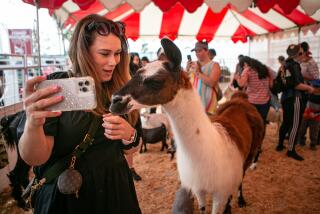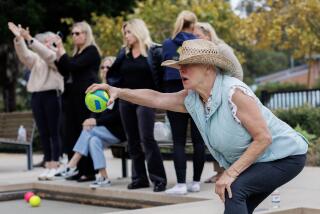It Has Their Number : Despite the Growth of Big-Time Gambling, Bingo Remains a Popular, Low-Stakes Drawing Card
- Share via
It’s a tense moment for 66-year-old Nina Cairo of Redondo Beach. She has already won twice, and she wonders if she’s on a streak.
Her hands fidget nervously with a lucky horseshoe magnet, coins, rings and other jewelry. She whispers the number 19 to herself, over and again, like a mantra.
A man at the podium reaches for the numbered ball, turns it over and says distinctly, “I-19.” Before the words are fully out of his mouth, Cairo is on her feet, arm over her head, yelling, “Bingo!”
Welcome to bingo night at the Manhattan Beach Knights of Columbus lodge, where one can play from 7 p.m. until about 11 p.m. for as little as $1 a card. Though the ambience is a tad Spartan and no drinking is allowed, the neighborhood is safe and close to home, and there’s a chance at a big jackpot. But it’s not the money that brings them in.
“It’s friendship, meeting people, and it’s fun,” said Thelma Pauly, 66, of Hawthorne, who comes every week with her sister, Alma Simpson, 73, of Hawthorne. It’s better than therapy, and it’s more interesting than television.”
At a time when many cities, including Inglewood, are moving toward legalizing high-stakes card clubs to boost revenues, the comparatively low-key bingo game remains a major draw in the South Bay.
“It’s the people,” agreed Louise Johnson, 71, of Redondo Beach, who rides with Cairo to bingo three or four nights a week at locations around the South Bay. “I go to senior bingo too. You only get a can of food there, but there’s still a thrill (of winning). That’s the only social life I have, really. I work as a senior aide at Hermosa Beach city hall, 20 hours a week. But this is my one vice. I don’t drink, I don’t smoke. Just play bingo.”
And play they do, across the South Bay, including Tuesdays and Sundays at Redondo Union High School, where a sports booster club puts on a game drawing up to 250 people at a time. St. James Catholic Church in Redondo Beach holds court on Thursday nights, with crowds of 75 to 100; the Knights of Columbus and the Eagles Club in Redondo hold sway on Friday; and on weekends, bingo is played at churches and senior citizen centers all over the area. Prizes range from canned goods to a $250 cash prize.
Bingo has been legal in California since 1976, with cities left responsible for licensing and monitoring local games. In the South Bay area, Torrance prohibits bingo while Carson licenses more than a dozen games.
Only charitable, senior citizen or mobile home associations are permitted to run them, and all profits must be used for some charitable purpose. Games must be administered and staffed by members of the organization and they cannot be paid for their duties. Additionally, no more than 20% of the proceeds may be used for administrative, security or facilities and equipment rental services. The maximum allowable prize under state law is $250.
In recent years, several area churches have disbanded their games, in part because of poor turnout. But other games flourish, like the Redondo Union Sea Hawk Booster Club’s, which has been around for two years.
School Principal Robert Paulson said parent volunteers staff the twice-weekly sessions that have been bringing in about $225,000 a year for a wide range of student activities and equipment.
“If for some reason the boosters ever decided to take their games elsewhere,” Paulson said, “every school in the area would be happy to have them.”
The game changes depending on what organization runs it. There is regular bingo, where a line of numbers straight up, straight across, on the diagonal or all four corners wins, and there are special games such as “picture frames,” in which all the perimeter numbers of a 25-square card must be called, or “blackout,” where every number must have been called. Some even play for “friendship”: a $1 bonus paid to the player sitting at either side of a bingo winner in certain games.
No longer a low-tech dinosaur, today’s bingo games have taken a few tips from Las Vegas. Tennis-size balls, each numbered and color-coded, are circulated in a compressed-air chamber, then forced upward one at a time to the caller, a volunteer who announces the letter and number (1 through 75) over a public address system. He then lays the ball down on a sensor board that lights the appropriate number on a huge screen at the front of the room.
Players may use wood-frame cards with colored plexiglass “sliders” to mark called numbers --these are “hard” cards--or darken the squares on printed paper “soft cards” with giant, brightly colored markers. Serious aficionados carry tote bags filled with watercolor markers in different colors; to provide variety--or luck--some use a different color for each of the night’s 20 or more games. Against the odds, some players win regularly, said Jim Cimino, a 15-year veteran who calls weekly at the Knights’ hall.
“I know people that go to Redondo Union every Sunday and Tuesday and win every week. Same thing with Thursday nights at St. James. There are people that win every week, same people win every week. I don’t know how. The cards really don’t matter, it’s just the way the numbers come up.”
Most, like Joyce Sanders, 62, of Torrance, say their winning nights come “not often enough. I think people have streaks. I need to start one this year--last year ended pretty bad.”
Cairo, on the other hand, took home more than $100 recently, all of which will be plowed back into bingo.
“I love everything about it--I just love bingo,” she exclaimed. “But my husband never goes to bingo. He says, ‘One gambler in the family is enough.’ ”


